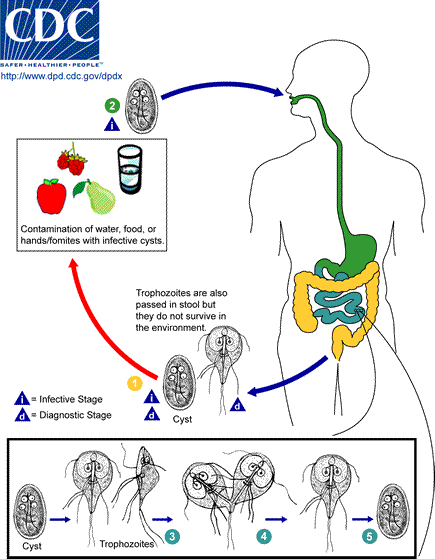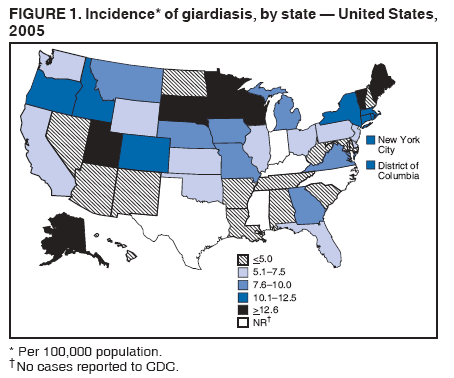Giardiasis
Giardiasis, also known as beaver fever, is a parasitic disease caused by Giardia duodenalis. This protozoan affects the gastrointestinal system, leading to symptoms such as diarrhoea, abdominal pain, and weight loss. Infected individuals may also experience nausea, vomiting, and blood in the stool. Symptoms usually manifest 1 to 3 weeks after exposure and can persist for several weeks or longer if untreated.

Signs and Symptoms
Giardiasis can range from asymptomatic to severe diarrhoea with malabsorption of nutrients. Chronic diarrhoea is the most prominent symptom and is often greasy, foul-smelling, and may float. This is typically accompanied by gas, abdominal cramps, nausea, and vomiting. Less common symptoms include itchy skin, hives, and swelling of the eyes and joints. Fever is rare, occurring in only about 15% of cases. Prolonged infection can lead to substantial weight loss, fatigue, and malabsorption of nutrients like lactose, vitamin A, folate, and vitamin B12. In children, chronic giardiasis can cause failure to thrive and may impair mental development.
Cause
Giardiasis is caused by Giardia duodenalis, which exists in two forms: cysts and trophozoites. The cysts are the infectious form, while trophozoites attach to the intestinal wall and replicate. Cysts can survive in cold water for nearly three months. The infection is common in animals like beavers, rodents, cows, and sheep, and these animals play a role in maintaining the presence of the parasite in the environment.


Risk Factors
Risk factors include poor sanitation, close contact with infected individuals, travel to areas with poor sanitation, and consumption of untreated water from natural sources. People at higher risk include those in childcare settings, travellers, backpackers, swimmers in contaminated water, and individuals with weakened immune systems.
Transmission
Transmission occurs through the faecal-oral route, primarily via contaminated water or food, and personal contact. Even asymptomatic individuals can spread the disease, making control challenging.
Pathophysiology
Giardia attaches to the intestinal wall, causing villous flattening and inhibition of enzyme activity, leading to malabsorption and diarrhoea. It affects the brush border enzymes and increases intestinal permeability, resulting in nutrient and water absorption issues.

Diagnosis
Diagnosis is primarily through stool tests detecting antigens. Microscopic examination is less preferred due to inconsistent shedding of cysts. Immunologic enzyme-linked immunosorbent assay (ELISA) testing is also used for diagnosis.

Prevention
Preventive measures include proper hand-washing, avoiding contaminated food and water, and using boiling or chemical disinfectants for water purification. Person-to-person transmission is common, necessitating good hygiene practices, especially in childcare settings and areas with poor sanitation.
Treatment
While the infection can resolve on its own, medications like metronidazole, tinidazole, and nitazoxanide are effective treatments. Albendazole is also used, showing equivalent efficacy with fewer side effects. In resistant cases, alternatives like quinacrine and paromomycin may be used. Probiotics can aid in the clearance of the parasite when used with standard treatments.
Prognosis
Most individuals with a functioning immune system recover without complications. However, chronic infections can occur, particularly in those with weakened immune systems. Children with chronic giardiasis may experience long-term effects such as growth stunting and failure to thrive.
Epidemiology
Giardiasis is prevalent worldwide, with higher rates in developing countries. In the United States, 3-7% of the population is affected, and it is associated with impaired growth in children. Seasonal trends show higher incidence rates in the summer months.

Self-assessment MCQs (single best answer)
What is the most common symptom of giardiasis?
How long after exposure do symptoms of giardiasis typically manifest?
Which of the following is NOT a common symptom of giardiasis?
What is the primary method of transmission for giardiasis?
Which diagnostic method is primarily used for giardiasis?
Which medication is NOT commonly used to treat giardiasis?
Which population is at higher risk for giardiasis?
What is the infectious form of Giardia duodenalis?
What percentage of giardiasis cases involve fever as a symptom?
Prolonged infection with giardiasis can lead to malabsorption of which nutrient?
Dentaljuce
Dentaljuce provides Enhanced Continuing Professional Development (CPD) with GDC-approved Certificates for dental professionals worldwide.
Founded in 2009 by the award-winning Masters team from the School of Dentistry at the University of Birmingham, Dentaljuce has established itself as the leading platform for online CPD.
With over 100 high-quality online courses available for a single annual membership fee, Dentaljuce offers comprehensive e-learning designed for busy dental professionals.
The courses cover a complete range of topics, from clinical skills to patient communication, and are suitable for dentists, nurses, hygienists, therapists, students, and practice managers.
Dentaljuce features Dr. Aiden, a dentally trained AI-powered personal tutor available 24/7 to assist with queries and provide guidance through complex topics, enhancing the learning experience.
Check out our range of courses, or sign up now!


